Which statement is true about an if-then rule evaluation?
- A. It can be evaluated more than once.
- B. It is evaluated once and only once.
- C. It must evaluate only native variable types.
- D. It cannot change the assessment for another if-then rule.
Answer : A
Explanation: http://www.oracle.com/partners/en/knowledge-
zone/applications/soasuite11g-1877659.pdf
Which two approaches are valid when using dynamic partner links in a BPEL process?
- A. A WSDL file, which contains multiple services that use the same portType, is available at design time, but the decision to determine which service is used can only be made at runtime.
- B. When the BPEL process is designed, the endpoint URL of the WSDL file is known but the services and port types are not known.
- C. When the BPEL process is designed, the services and port types of the WSDL file are known but the endpoint URI is not known.
- D. A WSDL file, which contains multiple services that use different portTypes, is available at design time, but the decision to determine which server us used can only be made at runtime.
Answer : A,C
Explanation: A (not D): How To Create a Dynamic Partner Link at Design Time for Use at
Runtime -
To create a dynamic partner link at design time for use at runtime:
-> Create a WSDL file that contains multiple services that use the same portType. etc
C (not B): The BPEL specification mandates that only the partner endpoint reference (EPR) can be changed dynamically. In BPEL terms, only the partnerRole of a partner link element can have a new value assigned. The myRole value doesn't change after the BPEL has been deployed.
Note:
* Dynamic Partner Links and Dynamic Addressing
During the design-time of an application, you may need to configure certain services whose endpoints (addresses) are not known beforehand, or it may be necessary to change an endpoint reference while the application is running. The Dynamic Partner link feature allows you to dynamically assign an endpoint reference to the partner link. This means that you can use one partner link for subsequent calls to different web-services (provided that the services use the same interface).
* For successful deployment of the process, a partner link should be completely defined.
When you deploy the project, the WSDL file for the partner link should contain and define both the abstract and the concrete information for the partner link, including address and port, though later the concrete information can be changed independently from the WSDL file.
View the Exhibit.
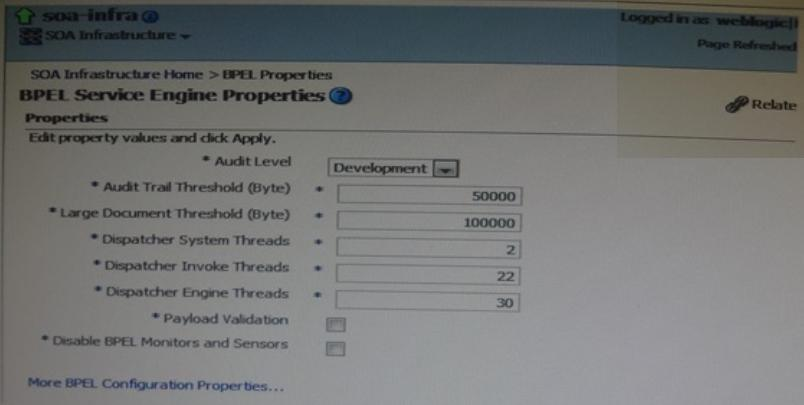
The Exhibit shows a display from Enterprise manager Fusion Middleware Control where you can monitor and manage BPEL service engine properties. Where are all changes to this configuration stored?
- A. bpel_config.xml in MDS
- B. soa-infra-config.xml in $MW_HOME/soa/config on each physical host in cluster
- C. soa-infra-config.xml in the soa-infra-wls.ear file
- D. a temporary directory on each physical host in the cluster
Answer : B
Explanation: * The main controls of Oracle SOA Service Infrastructure can be configured using the soa-infra-config.xml file located in the DOMAIN_HOME/ config/soa- infra/configuration directory. In this file you can specify:
/ The data source JNDI name for process dehydration.
/ The server and callback URL
/ The audit level of information to be collected by the message tracking infrastructure.
Note:
* In Oracle BPEL Process Manager 11g, you specify Oracle BPEL Process Manager engine properties in bpel-config.xml and soa-infra-config.xml (both are accessible as
MBeans).
* You can change the SOA Infrastructure ServerURL property port from Oracle Enterprise
Manager Fusion Middleware Control Console. This automatically updates the port setting in the soa-infra-config.xml file under $DOMAIN_HOME/config/Domain_Name/configuration.
* Since 11.1.1.2, bpel-config.xml is no longer available into the file system and therefore the only chance for modification is through EM Console.
* bpel-config.xml Configurations for BPEL Engine.
Incorrect:
Not C: Oracle SOA Service Infrastructure Services are contained in the soa-infra-wls.ear file.
Which two are beneficial results of a successful SOA governance initiative?
- A. Maintains a direct connection between business objectives and the production and consumption of services
- B. Provides technical standards for the creation of web services.
- C. Prevents the proliferation of services of questionable utility, reliability and business value
- D. Develops strategy maps and value-chain analyses that help define business requirements
Answer : A,C
By using the System Component Architecture (SCA) test framework, you can create tests for which three items?
- A. Reference binding components
- B. Service components like a Mediator
- C. Wires
- D. Invoke activities in a BPL process
- E. Composite sensors
Answer : A,B,C
Explanation: The test framework supports testing at the SOA composite application level.
In this type of testing, wires (C), service binding components, service components (such as
BPEL processes and Oracle Mediator service components) (B), and reference binding components (A) are tested.
Which expiration and escalation setting can be used to route a task a specified number of levels up a management chain if the assignee does not respond in a given time period?
- A. Never expire
- B. Expire after
- C. Route to manager
- D. Renew after
- E. Escalate after
- F. Management chain
Answer : E
Explanation: Figure, Escalate After Policy
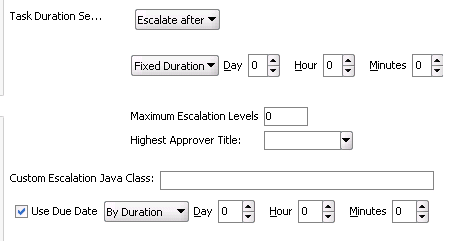
Each JCA adapter has a single deployment listed in the WLS Console. Identify two accurate descriptions about managing multiple instances of each adapter in the runtime.
- A. Instance configuration in the SOA Suite deployment plan
- B. JCA tiles for each adapter instance
- C. Adapter connection factories specified in the WLS Console
- D. One entry per adapter instance in the adapters_config.xml file
Answer : A,D
Explanation:
* The Oracle Database Adapter is a JCA 1.5 connector, which is deployed to the application server during installation.
The Oracle Database Adapter consists of multiple instances; each instance represents a connection to a database end point. Different SOA processes may point to the same adapter instance (database), while different service endpoints in a SOA process may point to different adapter instances (databases).
Because each adapter instance points to a single database, there is a one-to-one correspondence from adapter instances to application server data sources. Out of the box there is a single Oracle Database Adapter instance named eis/DB/SOADemo, which points to the data source jdbc/SOADataSource.
The list of adapter instances is stored in a deployment descriptor file, weblogic-ra.xml on
Oracle WebLogic Server. (It is inside of DbAdapter.rar, which contains also the Java class files in DBAdapter.jar). Configuring an Oracle Database Adapter instance is more about creating the underlying data source: getting the correct JDBC driver and connection URL.
You want to include documentation in the BPEL source code for a business rule component that you are adding to your BPEL model. How would you enter this documentation?
- A. As the value for a BPEL global variable
- B. As a comment attribute on the surrounding scope element
- C. As an annotation on the business rule component
- D. As user documentation on the business rule component
Answer : C
Explanation:
Note:
* Example
Viewing BPEL Source Code -
At the bottom of the window, you can use the BPEL Designer and BPEL Source tabs to switch between graphical editing mode (BPEL Designer) and text-editing mode for the source code of the BPEL process (BPEL Source). Two-way editing is enabled; that is, changes you make in one mode are reflected in the other mode.
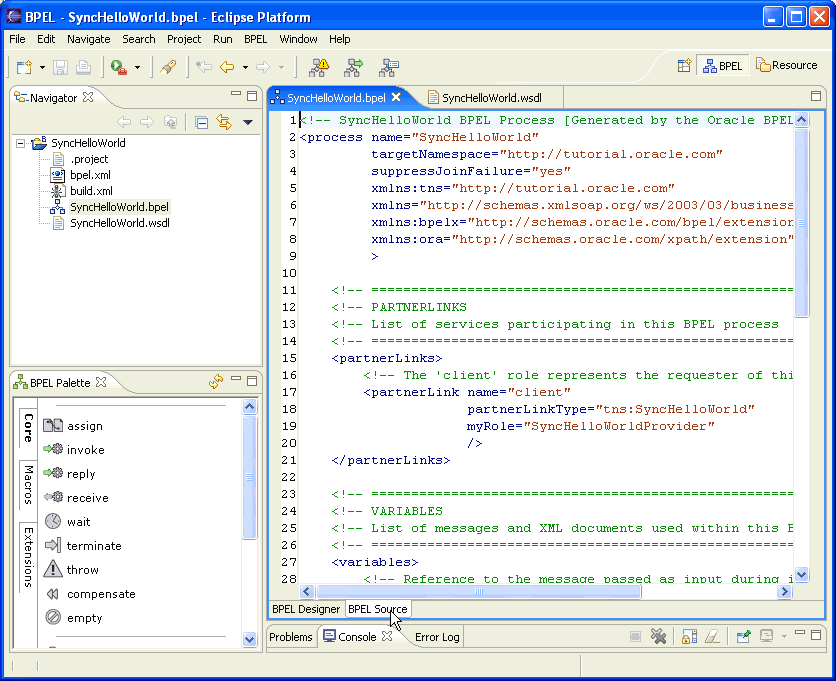
View the Exhibit.
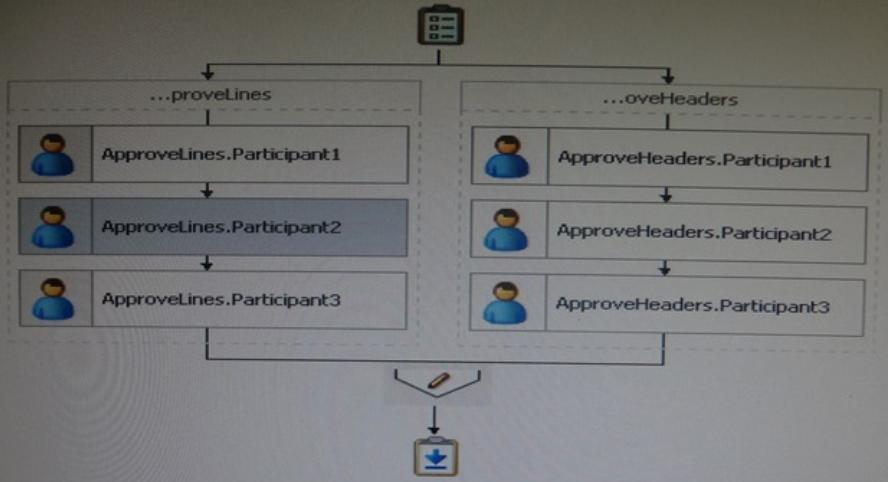
There are two groups acting on a task. The group on the left approves line items in the order.
The group on the right approves the order header. If any actor rejects the order the task completes without routing to any additional actors that have not yet acted on the task.
Identify the two options that should be selected in the human task definition to achieve this behavior.
- A. Complete parent tasks of early completing subtasks.
- B. Each parallel participant has a local copy of the payload.
- C. Complete task when a participant chooses the reject option.
- D. Enable early completion in parallel subtasks.
Answer : A,C
Explanation: A: Complete parent tasks of early completing subtasks:
This option is for environments in which you have multiple stages and participants working in parallel.
Participants perform subtasks in parallel, and one group's rejection or approval of a subtask causes the other group's subtask to also be rejected or approved.
C: Complete task when a participant chooses: <outcome>
A participant in a task can accept or reject it, thus ending the workflow without the task being sent to any other participant. For example, a manager rejects a purchase order, meaning that purchase order is not sent to their manager for review.
Incorrect:
Not D: Enable early completion in parallel subtasks
This option is for environments in which you have multiple stages and participants working in parallel.
Participants perform subtasks in parallel, and one group's rejection or approval of a subtask does not cause the other group's subtask to also be rejected or approved.
In a design session, a colleague makes the following comments about cluster support for
Oracle SOA Suite 11g application. Which two statements are correct?
- A. A cluster appears to clients as multiple WebLogic Server instances
- B. The server instances in a cluster must all run on the same machine.
- C. You can scale a cluster by adding machines to the cluster to host additional server instances.
- D. Server instances in a cluster can run different versions of WebLogic Server.
- E. You can create it cluster by using WLST, the WebLogic Server Administration Console or Enterprise Manager Fusion Middleware Control.
- F. For management purposes, you can split a cluster across multiple domains.
Answer : C,E
Explanation: C: Scale by adding machines:
* A WebLogic Server cluster provides these benefits:
Scalability -
The capacity of an application deployed on a WebLogic Server cluster can be increased dynamically to meet demand. You can add server instances to a cluster without interruption of servicethe application continues to run without impact to clients and end users.
High-Availability -
Incorrect:
Not A. They appear as one weblogic server instance.
Not B. They can run on sepate machines.
What is default transactional behavior for a synchronous request/reply and a one-way synchronous BPEL process?
- A. Required
- B. RequireNew
- C. Mandatory
- D. NotSupported
- E. Supports
Answer : B
Explanation: The default transaction for a synchronous process is requiresNew. That was until version 11.1.1.6. On this last version, you are asking to enter a Transaction parameter when creating a new synchronous bpel process.
Identify two service components that can be added to the components section of the SOA
Composite Editor.
- A. Database adapter
- B. BPEL process
- C. File adapter
- D. Business rule
- E. ADF-BC service
Answer : B,D
Identify three valid BPEL thread pools.
- A. Engine
- B. Callback
- C. Invoke
- D. System
- E. Service
Answer : A,C,D
Explanation: BPEL Threading Model
When the dispatcher must schedule a dispatch message for execution, it can enqueue the message into a thread pool. Each dispatch set can contain a thread pool
(java.util.concurrent.ThreadPoolExecutor). The BPEL thread pool implementation notifies the threads when a message has been enqueued and ensures the appropriate number of threads are instantiated in the pool.
The following thread properties can be tuned:
(C) Dispatcher Invoke Threads
-> Dispatcher Engine Threads
(D) Dispatcher System Threads
Dispatcher Maximum Request Depth
To add an xsi:type attribute to a target element, what needs to be mapped to the target element?
- A. A rename element on the canvas
- B. A recast element on the canvas
- C. An expression on the canvas
- D. A literal element on the canvas
Answer : D
Explanation:
Note:
* The xsi:type attribute is added beneath the original element, as shown in the figure below.
An S icon is displayed to indicate the node was substituted. You can map from any structural elements in the substituted type.
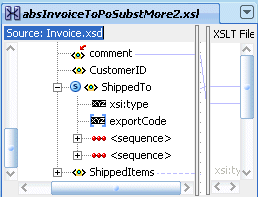
* The xsi:type attribute is used to identify derived complex types (as well as complex types that have been derived from).
* If you have elements in your XML file whose type is a complex type, xsi:type support in the XML editor lets you choose between the complex type and any other complex types derived from it.
You want to leverage the Event Delivery Network (EDN) in your composite application for publishing and subscription.
Which two components do you use?
- A. Business rule
- B. Mediator
- C. BAM adapter
- D. Spring component
- E. BPEL process
Answer : B,E
Explanation: B: Example:
Subscribing to the NewPO event -
-> Drag-and-drop a Mediator component on to the composite.
-> Name the mediator receiveNewPO.
-> Select Subscribe to Events for the Template.
-> Click on the + to add an event. Select the NewPO event from the Event Chooser window.
-> Click on OK to accept and create the mediator.
-> Save all.
-> Connect the receiveNewPO mediator to the routePO mediator:
Etc.
E: It is possible to subscribe to or publishing a Business Event from a BPEL Process
Service Component -
Note:
* The Event Delivery Network (EDN) in Oracle SOA Suite 11g provides a declarative way to use a publish/subscribe model to generate and consume business events without worrying about the underlying message infrastructure.

